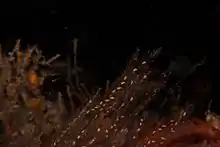Corhiza scotiae
Corhiza scotiae, the fine hydroid, is a delicate colonial hydroid in the family Halopterididae.[1]
| Corhiza scotiae | |
|---|---|
 | |
| Fine hydroid with reproductive bodies | |
| Scientific classification | |
| Domain: | Eukaryota |
| Kingdom: | Animalia |
| Phylum: | Cnidaria |
| Class: | Hydrozoa |
| Order: | Leptothecata |
| Family: | Halopterididae |
| Genus: | Corhiza |
| Species: | C. scotiae |
| Binomial name | |
| Corhiza scotiae (Ritchie, 1907) | |
| Synonyms | |
| |
Description

Fine hydroids at Torch Reef, False Bay, with multicoloured sea fan Acabaria rubra
Fine hydroids grow in colonies of long stems with fine brown to black branches. The colonies may grow up to 33 cm in height. The gonophores (reproductive bodies) look like small yellowish ovals, growing from the main stem of the colony.[2]
Distribution
This colonial animal is found off the South African coast from Saldanha Bay to East London in 18-120m under water. It is endemic to this region.[2]
Ecology
In this species, male and female forms live on separate colonies. Male gonophores are elongated and have blunt ends. Female gonophores bulge and have blunt lids.[2]
References
- "WoRMS - World Register of Marine Species - Corhiza scotiae (Ritchie, 1907)". marinespecies.org. Retrieved 2021-01-18.
- Millard, N.A.H. 1975. Monograph on the Hydroida of Southern Africa. Ann. S. Afr. Mus. 68:1-513
Wikimedia Commons has media related to Corhiza scotiae.
This article is issued from Wikipedia. The text is licensed under Creative Commons - Attribution - Sharealike. Additional terms may apply for the media files.